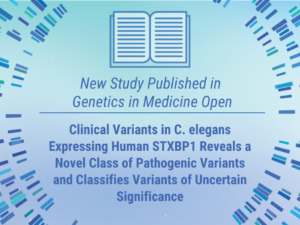Study Reveals New Class of Pathogenic Variants in the STXBP1Gene
Rady Children’s Institute for Genomic Medicine® (RCIGM), in collaboration with InVivo Biosystems, today released findings about a research study published in the journal Genetics in Medicine Open. This study will help medical teams determine the pathogenicity of a variant in the STXBP1 gene – which can cause severe seizures, intellectual disability, and developmental delays — to swiftly end the diagnostic odyssey for patients and their families.
While whole genome sequencing has become a more ubiquitous and inexpensive tool to rapidly diagnose critically ill children, there are an increasing number of variants of uncertain significance (VUS) which prevent patients from receiving a full diagnosis.
“The automated analysis we used in this study is an effective, scalable, and fast way to shed light on variants of unknown significance. We anticipate applying these techniques to more VUSes so we can end the diagnostic odyssey for so many more families.” said Matthew Bainbridge, PhD, associate director for clinical genomics research for Rady Children’s Institute for Genomic Medicine.
Acquiring a diagnosis is critical for obtaining effective therapy, medical reimbursement, and the achievement of a fully informed prognosis for the individual and family affected. The study of the STXPB1 gene also supports the strategic vision set forth by the National Human Genome Research Institute – to render the term “VUS” obsolete by 2030.
However, more than 80% of the hard-to-diagnose missense variants in the ClinVar database are VUS — a growth of 400-fold over the last 10 years, which has been 50 times faster than the growth in pathogenic assessments — so finding methods for rapid generation of functional data on variants is a growing priority for the research team.
“Being able to rapidly discern benign from pathogenic changes, and differentiate gain versus loss of function variants is critical to providing diagnostic answers to families affected by STXBP1-related disorders, while enabling development of effective therapies across the different mutation types that affect our patients,” said Charlene Son Rigby, president and co-founder of the STXBP1 Foundation.
For this research project, Hopkins et al. tested more than 80 variants in the STXBP1 gene for pathogenicity by changing out this gene in a C. elegans (a nematode worm) and replacing it with a human gene that conducts the same biological function. Using known benign and pathogenic gene mutations, researchers developed a machine learning model which correctly classified >90% of the variants. Further, the research team identified multiple classes of pathogenic variants with one subclass, seemingly imparting a gain- rather than loss-of-function phenotype.
“Once the humanized platform of the STXBP1 gene is established in the worm, we can test new variants in as little as two weeks — in some cases even faster,” said Chris Hopkins, chief scientific officer for InVivo Biosystems. “While not all genes are able to be tested in these worms, the STXBP1 gene does work well. We were able to test this volume of variants (80) because worm models are quick and inexpensive to work with and allow us to test more variants than we would have been able to test with mice.”
The research team at RCIGM and InVivo are looking to expand their research into other genes that have a high proportion of VUS using humanized C. elegans model system to help end the diagnostic odyssey for thousands more pediatric patients.

